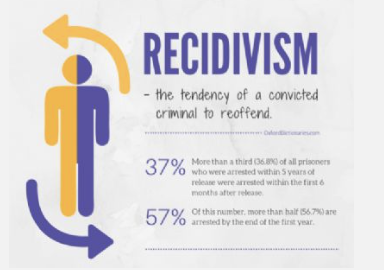 Across the United States, approximately 1.22 million people are incarcerated in state and federal facilities. This does not include the 3000+ county jails in the U.S. that have begun to hold longer-term prisoners as well. About a half million reentrants are released every year. In Marion County, Indiana alone, annual estimated releases are about 12,000. If recidivism is the yardstick we use to measure our ability to help reentrants create a new future, it is an uncertain one.
Across the United States, approximately 1.22 million people are incarcerated in state and federal facilities. This does not include the 3000+ county jails in the U.S. that have begun to hold longer-term prisoners as well. About a half million reentrants are released every year. In Marion County, Indiana alone, annual estimated releases are about 12,000. If recidivism is the yardstick we use to measure our ability to help reentrants create a new future, it is an uncertain one.
As the National Institute of Justice points out, "Recidivism is an inadequate measurement of success after release from prison." It is inadequate, because recidivism (a return to incarceration within three years of release) cannot be measured accurately. Some say it is as high as 70 percent. Others claim under 30 percent. It all depends on information that is more and more difficult to access due to efforts to maintain the privacy of all citizens. If a man, for example, spends three years in the Marion County Adult Detention Center, and a year later is incarcerated in Clark County, on the southern border of the state, there is no way to dependably attach that conviction to that person. It is somewhere in his criminal dossier, but researchers can only find numbers, and numbers will not tell us if he became a recidivist, or not.
A 2005 study of reentrants in 30 states, by the Bureau of Justice Statistics reported that 37 percent of those released were re-arrested within the 6 months, and 57 percent were re-arrested by the end of the first year. No wonder so many claim recidivism is really around 70 percent after three years. From the information we have been able to access through Indiana Department of Correction and others, we are finding recidivism rates around Central Indiana to range from around 30 percent to around 55 percent, depending on the county, but that too could be lower than actual.
Still, we do this as an effort to provide a yardstick by which to measure our work, and because recidivism represents—at some level— the failure or success of our society to help a meaningful number of reentrants to find a new and successful life after incarceration.
Here's why we have to help: High levels of recidivism cause high rates of poverty. Studies show that children of incarcerated adults suffer with inadequate access to nutritious food, health care, and educational opportunities. Families that can and do heal after dad or mom has been in prison are torn again when re-incarceration is required. But studies also show that mentorship and a good job, acquired soon after release is a powerful agent of change in the lives of those returning from prison and long-term jail sentences and can cut recidivism drastically.
Our efforts at 2nd chance job procurement and support services, connecting reentrants to housing, food, drug abatement, and more, have placed our work in the middle of a growing understanding of the need to help reentrants improve the economic foundation of their families and reduce actual poverty, as well as the poverty mindset expressed by so many of those we work with who believe they will never succeed.
Nancy








